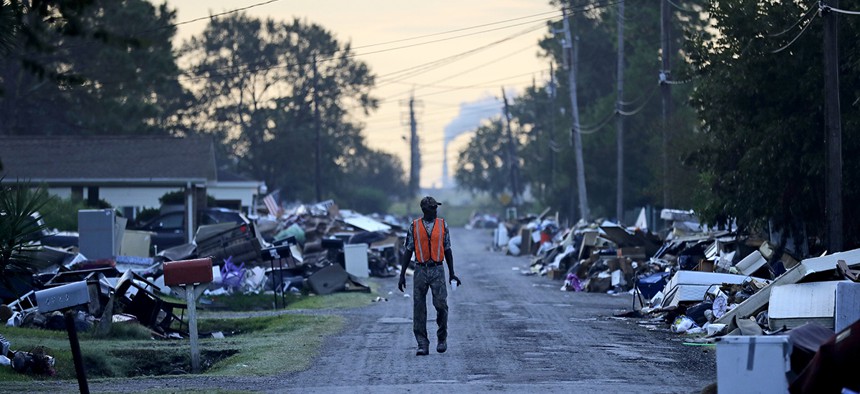Here’s What Citizens Taught Feds During Disasters

A man walks past debris from homes on his street damaged in flooding from Hurricane Harvey as an oil refinery stands in the background in Port Arthur, Texas, Thursday, Sept. 28, 2017. David Goldman/AP
After the summer's hurricanes, agencies are looking at how everyday people can help in disaster relief efforts.
When a disaster strikes, first responders need all the help they can get, and federal officials think citizens can pitch in now more than ever before using social media, drones and other modern technology.
After hurricanes devastated Texas, Florida and Puerto Rico, federal responders saw firsthand how everyday people used technology to get help and save lives. As agencies start rethinking how they respond to disasters, government officials think crowdsourcing that tech can boost federal relief efforts.
“If you can design, administer and control the crowdsourcing of help, I think that’s a tremendous opportunity for what really is a very tech-savvy body of citizenry,” said Greg Garcia, chief information officer of the U.S. Army Corps of Engineers.
Garcia joined federal responders on a panel at the AFCEA Mobile Tech Summit to outline some of the lessons learned from this year's particularly violent hurricane season. While the disasters revealed shortcomings in local disaster planning and communications infrastructure, they revealed how the government could utilize social media to get resources where they’re most needed.
In each disaster, victims took to Facebook and Twitter to alert responders to their location and call for help. The platforms proved particularly useful when emergency call lines became overwhelmed after Hurricane Harvey, said Valerie Boyd, a Coast Guard liaison to the Federal Emergency Management Agency.
Boyd, who has been involved in federal disaster response since Hurricane Katrina, said accessing Facebook and Twitter was initially prohibited in Coast Guard command centers. While responders initially advised survivors to call 911 instead of posting on social media, it quickly became clear that many people could only reach out for help online.
“When communications lines are down and you need help, what are you going to do?” said Boyd in a conversation with Nextgov. “We need to adapt. You have to change with the times.”
The Coast Guard has since revised its policy on social media, she said. Responders are not only allowed to monitor Facebook and Twitter, they’re required to do so.
“That one response to Hurricane Harvey has completely changed the way we operate,” Boyd said.
Another area where citizens can get involved is in search and rescue missions, particularly if they own personal drones, said Garcia. Search and rescue is usually one of the first things responders do when they arrive in a disaster zone, and Garcia thinks local drone pilots could assist federal efforts from the air with proper government oversight.
“There are probably hundreds of thousands of people who own drones who want to help,” Garcia said. “They want to help, and they’re willing to subject themselves to all these constraints to help.”
The government would have to closely control such missions to keep the airspace from becoming dangerous, he said. While there isn’t yet a system in place to do so, Garcia believes it’s better to start working out this and other future recovery plans sooner than later.
“You always are 20/20 hindsight,” he said. “The lesson we have to figure out is how to build in resiliency before you need it.”
NEXT STORY: 5 Companies Protest Alliant 2 Contract—So Far






